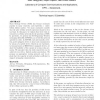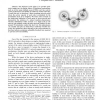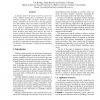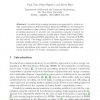476 search results - page 38 / 96 » Computing the Capacity Region of a Wireless Network |
WMASH
2004
ACM
14 years 1 months ago
2004
ACM
Short Message Service (SMS) has become extremely popular in many countries, and represents a multibillion dollars market. Yet many consumers consider that the price cellular netwo...
WIOPT
2006
IEEE
14 years 1 months ago
2006
IEEE
Abstract— The objective of the paper is to provide qualitative insight into the global effects of distributed mechanisms, such as carrier sense multiple access (CSMA) and rate co...
EUROMICRO
2004
IEEE
13 years 11 months ago
2004
IEEE
A primary goal in the design of wireless sensor networks is lifetime maximization, constrained by the energy capacity of batteries. One well known method to reduce energy consumpt...
ISCIS
2005
Springer
14 years 1 months ago
2005
Springer
Abstract. In-network processing emerges as an approach to reduce energy consumption in Wireless Sensor Networks (WSN) by decreasing the overall transferred data volume. Parallel pr...
ICC
2008
IEEE
14 years 2 months ago
2008
IEEE
—Wireless sensor networks are often composed of resource-constrained sensor nodes with limited memory space, computational capacity and communication range. The links in WSN are ...




